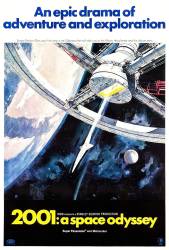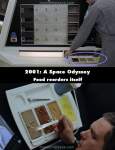Other mistake: There is something drastically wrong with the design of the spherical 'Aries' moon shuttle. Some seats and many fixtures are 'upside down' relative to the up-down orientation of the shuttle itself, and we see loose food trays and equipment about the place as if this is routine. But - the shuttle is designed to land on the moon. What happens then? The moon has gravity, remember? There are going to be quite a few very disgruntled people dangling upside down like spiders, and there will be loose gear (and perhaps a stewardess or two) bouncing about all over the place. It is not a matter of stowing loose gear or lying flat on landing - some parts of the shuttle are upside down relative to others, which is why the stewardess has to do that famous 180 degree upside down walk. Whichever way you look at it the shuttle is going to encounter serious problems when it reaches a gravity well, which will occur whenever the engines are fired up, never mind landing on the moon.
Trivia: People speculate that HAL is a reference to IBM, as the letters differ by one position. Kubrick says this is a coincidence, but was concerned about IBM's reaction to the film's references, including the IBM logo on Bowman's spacesuit. However IBM had no problem as long as they weren't associated with the "equipment failure," or listed as technical advisors for the computer.
Suggested correction: Despite decades of rumors regarding the relationship between Kubrick's "2001: A Space Odyssey" and IBM, the fact is that IBM worked very closely with the production (assisting and advising on futuristic onscreen computer effects), and there was never any conflict or concern with IBM's reaction to the film.
Revealing mistake: When Dave Bowman attempts to re-enter Discovery One via the emergency airlock after blowing the explosive bolts on the pod door, where does said pod door go? And also, because of Newton's law of motion, the sudden rush of cabin air during decompression inside said pod after the bolts had blown the door off would have resulted in the pod being pushed in the opposite direction (in effect, that rapid escaping air would have acted like a rocket motor, propelling the pod like a cannonball from a gun!).
Suggested correction: Did you watch the film? The pod bay door doesn't come into it. Bowman enters via the emergency entrance, not a pod bay. The door of the pod and the door of the emergency exit slide sideways into cavities that are there for that purpose - hinged doors don't make any sense in a cramped spacecraft. We see the emergency entrance doorway slide back into position when Bowman activates it.
I think you confused the pod bay door with the door on the pod itself. In the explosive bolt sequence, the pod door does disappear. There is an expanding cloud from the pod door, but no flying door or evidence of it in the emergency airlock. Just an open hole in the pod.
In the scene just before HAL reads the astronauts' lips in the pod, we see that the pod door does slide sideways into the pod hull. The explosive bolts, marked by small red patches, are located in a pattern all around the edge of the door. This indicates that the explosive bolts would blow that section of the door outward rather than sideways into the hull storage pocket.
Bowman programmes the bolts on one side of the door only to detonate, blowing it sideways.
Sure, that might work, but how about this? Bowman knows that the door is constructed of a special composite material that instantly vaporises if it is compressed in just the right way. So, he reprograms the charges to set up a harmonic series of shock wave fronts that destabilises the composite of the door structure, tuning it into the large cloud of smoke we see in the scene.







Suggested correction: The shuttle lands "on its back" with legs extending beyond the engines. As in most traditional sci-fi, and ALL actual, space flights to date, the launch (and landing) orientation for humans is to be on one's back. This minimizes blood being sucked down to your feet if you were sitting upright at launch - you could pass out. So we see this when the shuttle lands on the moon - the cockpit (red window) faces up (pilots on their backs, facing out the window). When we presume that the passenger cabin was 180 degrees spun around from the cockpit seating, they're still on their backs. Any loose objects would have been stowed before landing - the airlines don't lock down your bags, newspapers and coffee cups, right? They're loose in the cabin during flight, but put away on takeoff and landing.
Airliners do not fly upside down. The Orion shuttle cannot possibly operate the way it does if it lands in a gravity environment - some rooms are upside down relative to others - why else would the stewardess do the 180 degree vertical walk? It is an idiotic design flaw, and the posting is 100% correct.
The Aries passengers sit and stand with their feet down towards the moon. The pilots sit with their back down to the moon, as conventional astronauts do on Earth. But the attendant's 180-degree walk is completely wrong to the orientation of the shuttle's interior: it should have been only 90° if you look at the Aries exterior. One assumes that Kubrick preferred a longer, more cinematic shot, over a technically accurate shot. But nobody was upside-down to the moon.